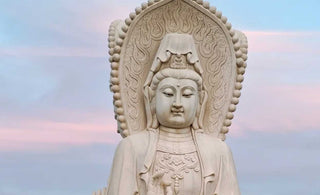
Among the many treasures that embody the essence of Oriental aesthetics, Guanyin Bodhisattva stone statues hold a special place. These statues represent the embodiment of grace and compassion, captivating the hearts of collectors, artists, and enthusiasts around the world.
The Symbolism of Guanyin Bodhisattva
Guanyin, also known as Avalokitesvara, is a revered figure in Mahayana Buddhism. As a Bodhisattva, Guanyin exemplifies compassion and mercy, vowing to assist all sentient beings on their path to enlightenment. The stone statues of Guanyin beautifully capture the essence of this compassionate deity, making them highly sought after by art connoisseurs and spiritual seekers.
Central to Guanyin's symbolism is the embodiment of compassion. As a Bodhisattva, Guanyin is believed to have postponed attaining enlightenment to alleviate the suffering of sentient beings. The Guanyin Bodhisattva stone statues beautifully depict this compassionate nature, radiating a sense of warmth, kindness, and empathy. The statues of Guanyin exude an aura of graceful serenity. With gentle expressions and serene postures, they invite a sense of calm and tranquility. The artists who craft these statues skillfully capture the essence of inner peace, allowing viewers to experience a profound connection with the divine and a moment of respite from the chaotic world.
One of the unique aspects of Guanyin Bodhisattva is the fluidity of gender. Guanyin is often depicted as both male and female, transcending traditional gender boundaries. This reflects the idea that compassion knows no limits and extends to all beings regardless of gender or identity. The Guanyin Bodhisattva stone statues embrace this fluidity, reminding us of the power of universal love and acceptance. The Guanyin Bodhisattva stone statues are renowned for their exquisite beauty and attention to detail. Crafted by skilled artisans, these statues depict Guanyin in various poses and forms, each carrying its own symbolic meaning. Whether portrayed as a standing figure with flowing robes or in a seated position exuding tranquility, every statue emanates a sense of grace and serenity.
Guanyin Bodhisattva stone statues are often adorned with symbolic attributes that enhance their spiritual significance. One of the most common attributes is the lotus flower, symbolizing purity and enlightenment. The lotus, rising above the muddy waters, represents the transcendence of worldly suffering and the attainment of spiritual liberation. Another common attribute is the "Willow Branch of Compassion," which Guanyin holds in her hand. The willow branch represents flexibility and the ability to adapt to changing circumstances, while compassion remains unwavering. These symbolic elements add depth and meaning to the statues, inviting contemplation and inspiring spiritual growth.
Materials and Techniques
The choice of stone plays a crucial role in the creation of Guanyin Bodhisattva statues. Various types of stones are used, each with its unique characteristics and aesthetic appeal. Marble, granite, and jade are among the commonly used stones in crafting these statues. Marble, with its smooth texture and range of colors, offers a graceful and elegant appearance. Granite, known for its strength and durability, provides a solid and enduring foundation for the statue. Jade, highly valued for its translucency and symbolic significance, adds a touch of prestige and reverence to the artwork.
The process of sculpting and carving a Guanyin Bodhisattva statue requires immense skill and precision. Experienced artisans employ traditional sculpting techniques, using various tools such as chisels, hammers, and rasps to shape the stone. They begin by creating a rough outline and gradually refine the details, bringing the statue to life. The sculptor carefully carves the facial features, the flowing robes, and the intricate accessories, ensuring that every aspect is meticulously crafted to capture the essence of Guanyin's compassion and grace.
Once the carving process is complete, the statue undergoes a meticulous finishing and polishing stage. This involves smoothing out any rough edges, refining the surface, and bringing out the natural luster of the stone. Artisans employ sandpaper, files, and polishing compounds to achieve a flawless finish. The polishing process enhances the visual appeal of the statue, giving it a refined and radiant appearance.
Throughout the centuries, various regional styles and variations of Guanyin Bodhisattva stone statues have emerged, each reflecting the unique artistic traditions of the region. In China, for example, the stone statues often exhibit a serene and gentle expression, while statues from Southeast Asia may feature more intricate details and vibrant colors. The diversity in regional styles allows collectors and enthusiasts to appreciate the wide range of artistic interpretations of Guanyin Bodhisattva. It also showcases the cultural exchange and influence that has shaped Oriental art throughout history.
Spiritual Significance and Devotional Practices
Guanyin Bodhisattva stone statues hold immense spiritual significance for devotees of Mahayana Buddhism. They are regarded as sacred objects of veneration and are often placed in temples, shrines, and personal altars. Many individuals turn to Guanyin as a source of comfort, compassion, and guidance in times of difficulty. Devotional practices associated with Guanyin Bodhisattva include chanting of mantras, recitation of sutras, and the lighting of incense as offerings. These practices create an environment of reverence and deepen the connection between the devotee and the compassionate energy embodied by Guanyin. For collectors and art enthusiasts, Guanyin Bodhisattva stone statues hold both aesthetic and spiritual value. Acquiring these statues allows one to appreciate the artistry, craftsmanship, and symbolism that define Oriental aesthetics. When selecting a Guanyin statue, factors such as the quality of the stone, the skill of the artisan, and the overall aesthetic appeal should be considered.
In short, Guanyin Bodhisattva stone statues embody the grace and compassion that lie at the heart of Oriental aesthetics. These masterpieces of art and spirituality have captivated the world with their exquisite beauty and profound symbolism. Our commitment to preserving and promoting Oriental art allows us to offer a unique selection of Guanyin Bodhisattva stone statues, sourced from esteemed artists and collectors. With each statue, you can own a piece of history and immerse.
























